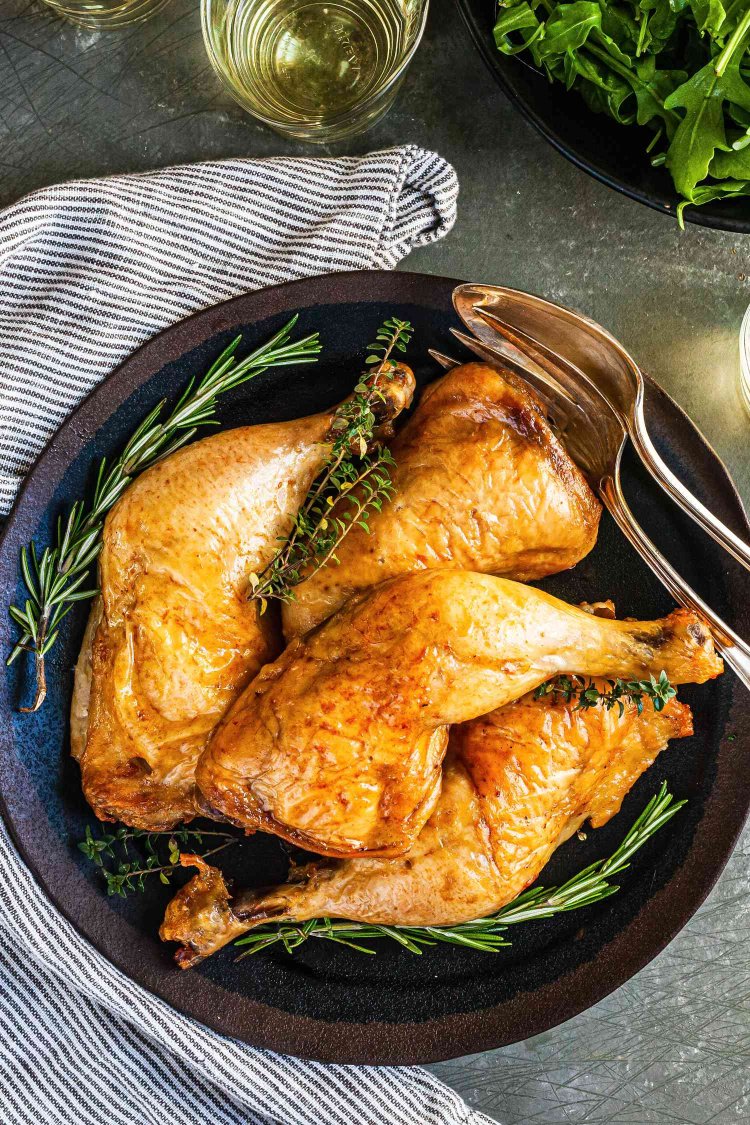Chicken Confit
This may be the most impressive chicken you’ll ever cook. Chicken confit is tender, juicy, and totally okay to store in the fridge for up to one month.

Chicken confit in the back of your fridge is like money in the bank for a future meal. You’re in for a tasty surprise plus a night off from cooking someday down the road!
When slowly simmered in olive oil, chicken becomes meltingly tender, stays moist, and keeps in the refrigerator for at least one month (as long as it is submerged in the oil). When you’re ready for dinner, pull it out and sear or roast it until the skin is crispy. Serve it with your favorite sides, top it on a salad, or shred it for tacos or burritos.
What Is Confit?
Confit is a way to preserve meat by slowly cooking it at a low temperature fully submerged in fat or oil. Duck or goose confit, originating from the Southwest region of France, are most well-known. They use rendered duck or goose fat to cook and store the meat through the winter months. You can confit other meats like chicken, pork, lamb, and even vegetables.
Confit is low and slow cooking with the meat fully submerged in fat or oil. For this recipe, I use olive oil. At a low even temperature, the oil transfers heat more gradually to food than water does at the same temperature. All that translates into gentle cooking with very tender and moist results.
:max_bytes(150000):strip_icc():format(webp)/Simply-Recipes-Chicken-Confit-LEAD-6-33f44cdc03244424b4c7bf8a5a13a7c5.jpg)
Simply Recipes / Sally Vargas
How to Confit Chicken
Despite sounding like a super cheffy and difficult dish, making chicken confit is mostly a waiting game that can be broken down into three steps:
- Salt the chicken, tuck in some garlic and herbs, and refrigerate it for 24 hours. This helps preserve and season it.
- Submerge the chicken in olive oil and slowly cook it at a low temperature for about 1 1/2 hours.
- Cool the chicken and store it in the refrigerator, fully submerged in the olive oil, for up to 1 month (if it lasts that long without being devoured).
This recipe calls for cooking the chicken in the oven. This is my preferred method, since you don’t have to monitor it too much. There are two other ways to cook the chicken:
Stovetop method: Simmer the chicken on the stovetop over a very low heat so that only a few bubbles appear at a time. You’ll have to keep an eye on it to make sure the heat is consistently low and even.
Slow cooker method: While I have not tried confit in a slow cooker, you could set it on the lowest heat setting and then kind of forget about it for about 6 hours.
Best Cut of Chicken for Confit
Whole chicken legs (the thigh and drumstick are attached) make a nice presentation, but you could use chicken thighs or breasts with the skin and bone intact.
All About the Fat
While duck fat is traditionally used to confit poultry, it is expensive and sometimes hard to find. I use olive oil with excellent results.
Does cooking the chicken submerged in all that olive oil make it fatty and greasy? Well, not exactly. The oil helps cook and tenderize the chicken, but it does not penetrate deeply into the meat.
After you’ve eaten the chicken, strain the oil, store it in the refrigerator for a month or so, and use it for cooking. It is so flavorful! Keep in mind that olive oil solidifies in the refrigerator. This doesn’t affect the quality. Let it sit at room temperature before using—it’ll return to its liquid state.
:max_bytes(150000):strip_icc():format(webp)/Simply-Recipes-Chicken-Confit-LEAD-3-a5dcffb3ea5049a1a5a5b1ee78d9ed8a.jpg)
Simply Recipes / Sally Vargas
Ideas for Substitutions
Instead of whole chicken legs, you could use skin-on, bone-in breasts and thighs. You could also switch up the aromatics: rosemary, sage, oregano, cloves, star anise, coriander, and juniper berries, to name a few.
How to Serve Chicken Confit
So easy! Instant supper! Pull a leg or two out of the fridge, scrape off some of the congealed oil, and sear them in a non-stick skillet until the skin is golden brown and crisp, and the meat is warmed through. Just add a side salad and your favorite carb, and dinner is done.
Other uses for Chicken Confit:
- Shred the meat into a tortilla.
- Add it to a pot of beans.
- Use it in a cassoulet.
- Make it into a ravioli or savory crêpe filling.
- Shred the meat and add enough olive oil to make a spread (it’s called rillette). Serve it on toasted slices of baguette.
How to Store Chicken Confit
The chicken should be store in a squeaky-clean container sterilized in the dishwasher or in boiling water, preferably glass or earthenware. It does not have to be in one layer, but it should be fully submerged in the oil. Cover with plastic wrap and then foil or a tight lid, and refrigerate for up to one month.
Technically, you could freeze chicken confit for longer storage, but the texture of the meat will suffer, since small ice crystals will form around it.
Ingredients
-
4 to 6 skin-on, bone-in whole chicken legs (3 1/2 to 5 pounds total)
-
1 teaspoon salt
-
1/4 teaspoon freshly ground black pepper
-
3 cloves garlic, halved
-
4 sprigs thyme
-
4 whole cloves
-
3 bay leaves
-
4 to 5 cups olive oil
Method
-
Prepare the chicken:
Place the chicken into a large baking dish and sprinkle them all over with salt and black pepper. Tuck the garlic, thyme, cloves, and bay leaves around the chicken. Cover the dish with plastic wrap and refrigerate for 24 hours. You could do this in a large bowl.
:max_bytes(150000):strip_icc():format(webp)/Simply-Recipes-Chicken-Confit-METHOD-1-eaf15307c3554fcb87c8f4428da737ec.jpg)
-
Preheat the oven to 250ºF.
-
Cook the chicken:
Remove the chicken from the baking dish and use a paper towel to wipe off the aromatics and pat them dry.
In a large Dutch oven or an ovenproof pan that is at least 3 inches deep, arrange the chicken in one layer. I can fit 5 whole chicken legs in a 12-inch pan. Cover with enough olive oil to barely submerge the chicken, 4 to 5 cups.
Set the pan over medium heat until a few bubbles appear. The oil should measure about 125ºF with an instant-read thermometer. It will take 15 to 20 minutes.
Cover the pan with foil or a lid and place it in the oven. Cook for 1 1/2 to 2 hours, until the meat can be easily pierced with a skewer and the juices run clear.
Check after the first 15 minutes to make sure the oil is just barely bubbling. If it’s not bubbling at all or if it is wildly boiling, adjust the oven temperature up or down by about 10 degrees. Check again at the 1 1/2-hour mark.
:max_bytes(150000):strip_icc():format(webp)/Simply-Recipes-Chicken-Confit-METHOD-2-fed10bbff0b141c2859b854f05880713.jpg)
:max_bytes(150000):strip_icc():format(webp)/Simply-Recipes-Chicken-Confit-METHOD-3-f45505379a494442a9e227f5ef49d7d0.jpg)
Simply Recipes / Sally Vargas
-
Cool the chicken:
Remove the pan from the oven and let the chicken cool in the oil for 30 minutes.
Transfer the chicken onto a platter to cool to room temperature for about 1 hour. Set a fine-mesh strainer over a deep glass or earthenware dish and strain the oil into it. Let it cool to room temperature. Discard the aromatics.
:max_bytes(150000):strip_icc():format(webp)/Simply-Recipes-Chicken-Confit-METHOD-4-0549b51a5b77417ba3bd48443d7ebe7b.jpg)
-
Store the chicken:
Transfer the cooled chicken into the oil. The chicken should be fully submerged in the oil. Cover the dish with plastic wrap and then foil. Store it in the refrigerator for up to a month.
:max_bytes(150000):strip_icc():format(webp)/Simply-Recipes-Chicken-Confit-METHOD-5-aed3fb43ffab4736ba2b7a736dca10a9.jpg)
-
Two options to heat the chicken:
In the oven: Preheat the oven to 400°F. Remove the chicken from the oil and scrape off some of the congealed oil. Set them on a rimmed baking sheet or roasting pan, skin side-up. Roast for 25 minutes, until the skin is golden brown and crisp.
On the stovetop: In a large non-stick skillet over medium-low heat, add the chicken skin side-down. Cook until the skin is golden brown and crisp, about 10 minutes. Flip the chicken over and cook the other side for 2 to 3 minutes to finish warming them through.
-
Serve the chicken:
Transfer the chicken to a serving platter or individual plates. Serve with roasted potatoes, a green salad, or your favorite vegetables.










